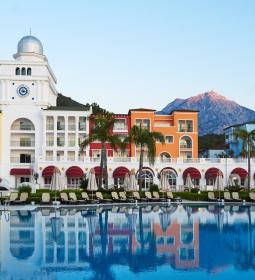Romania is underestimated by many, a similar situation with their national cuisine. There is a little talk about it, but tourist reviews are usually the most enthusiastic. It is a kind of Balkan, somewhat reminiscent of Serbian, Bulgarian, Macedonian or Turkish, but with a special approach.
There are nutritious soups, delicious sausages, vegetable snacks, cheese and pastries. We will tell you what to try for a tourist or a visitor to an ethnic restaurant - if, of course, you can find one. In general, the Romanian table was born at the junction of two national cuisines - the lord's German (meat dishes, cheeses, etc.) and the common people - here mainly homany and derivatives.
Chorba
This is a universal name for all thick soups of national cuisine - both made from meat (beef, pork, veal), chicken, fish, and with sausages or meatballs. Common qualities - fat, aroma and extreme saturation after one serving.
The most popular in this section is chorba de burta,making it from a cow's rumen.

By the way - these are not tourist dishes, they are often used in the daily menu by the most ordinary people. So in the store you can easily find a scar prepared and passed all the preliminary caresses. Cook soup with bones, tomatoes and various roots, from potatoes and above. Five minutes before cooking, a mixture of cream, eggs and lemon juice should be added to the pan, which makes the soup more delicate and more viscous. Traditionally seasoned with garlic sauce and sour cream, eat a snack with herbs and a bun of white.
Tochitura
Usually the second in Romanian, something from meat. Tochitura - stew in Transylvania, will go with a bang to connoisseurs of spicy dishes from fatty pork. Prepare as follows: smoked sausage, cubes of meat and bacon are fried in oil, then they are stewed in a sauce of tomatoes, wine, garlic and spicy herbs on low heat. Served with corn porridge and scrambled eggs. Wonderful goes to the local red wine.
A good cook covers the tochitura with a lush cap of cheese. The best in the country is in the restaurant "Curacu Bere" in the center of Bucharest.
Mititei
This is the most common Romanian street food - mititea on gratar. Juicy, as made from the meat of calves and young lambs with a meat cool broth, which during grilling soaks the meat and leaves with steam. In terms of spices, garlic, pepper, salt and thyme are heartily baked here, other herbs are less often used. During frying, the spirit of the sausages is such that for five blocks it is felt. Great go to beer, but not to Romanian - it's so-so.
On the Black Sea coast, they sell in pita or pita bread, and in the capital and Transylvania, usually so, on a skewer or fork.
Sarmale

Very affordable rolls with minced rice and meat. The filling is wrapped in a leaf of cabbage or grapes. Juicy, tender and nourishing. It is recommended to try with homany, thick porridge of corn, a traditional side dish in these places. The addition will serve as stewed cabbage, vegetable cuts and a few hot peppers. Another option: sour cream, butter and finely chopped greens.
Romanian kebab
Another street food. It can be from any meat, be it a cow, pig, lamb or chicken with turkey. The devil is in the details - pieces of meat alternate with mushrooms, bacon, smoked sausage, tomatoes, onions and sweet peppers. Languishing on coals, vegetables and meat impregnate each other with juice, and the addition of spices such as thyme, garlic, rosemary and ginger, gives an unforgettable spicy taste. There is a vegetarian version - instead of meat eggplant.
Pastr sandwiches
He is the lord of stomachs, human destinies and Romanian ethnic street food. Pastrmi is a delicious beef, marinated, smoked, generously peppered, and then dried.
Served in both expensive restaurants and village eateries. In the cities, you can buy from the stalls as part of the aforementioned sandwich. Served in a crispy bun with fresh vegetables, pickled cucumber, processed cheese from northern Romania, omelet and sauce. In the sandwich there are two types of cutting at once - fried and smoked.
Great with beer or kvass.
Boulz
Outside of Romania, you will not find this - it is not popular. It is a browned kolobok the size of a fist or a large lemon, hides the filling of meat, mushrooms, processed Romanian cheese. And the shell is not made of dough - from homila: soft inside, but on top with a crispy crust. This porridge is mixed with local cheeses. Usually, the gulzam is accompanied by sour cream, pickled cucumbers, hot peppers, charcoal meat or scrambled eggs/omelets.

Caviar salad
This traditional snack is served both in village taverns and restaurants, especially on the coast or in the capital. It is prepared from cod, carp or any other river caviar (fish is abundantly provided to cooks by the leisurely Danube).
The raw material is mixed with the pulp of white bread, onion, squired with lemon juice and vegetable oil, then seasoned with mayonnaise. Sold ready in the supermarket in trays like pate. In the morning with bread - wonderful.
Eggplant salad
On the second Romanians respect not only meat, vegetables also do not forget. For example, this snack of baked eggplant. The vegetable is skinned, pre-baked in the oven or grill, and then crumple, mixing with lemon juice and pepper. Served warmly, seasoned with sunflower or olive oil, mayonnaise or sour cream (lemon or orange juice is added to the latter), with onions, tomatoes or fried peppers. As side dishes are also good national cheeses - telemea, cheese from burdyuks and kashkaval. The final touch is a pita or a loaf.
Papanash
This is a very cool and popular Romanian dessert. Eat usually or in the afternoon, but more often for breakfast with coffee. It is a doughnut stuffed with juicy cheese, served in sour cream sauce and jam of raspberries, strawberries, mulberries or currants.
Papanash is a suitcase with a double bottom. Two-layered, I mean. The lower layer is crowned with a hole, where cheese and berries are poured, and on top they cover with a lid of cottage cheese like cheesecake, only with a ball. Melts in your mouth and instantly disappears from the plate, once you are on the table.













